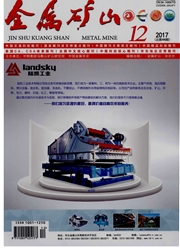

 中文摘要:
中文摘要:
针对矿井中发生的冲击地压危险性分级问题,应用因子分析和Fisher判别分析理论,选取煤层厚度、煤层倾角、埋深、构造情况、煤层倾角变化、煤层厚度变化、瓦斯浓度、顶板管理、卸压、响煤炮声为影响因素,分析影响因素之间的相关性,对相关性较强的因素进行因子分析,提取恰当的公共因子,进而建立基于因子分析的冲击地压危险性等级Fisher判别分析( FDA)模型。利用四川砚石台煤矿23组实测数据作为学习样本对模型进行训练。采用回代估计法检验模型的有效性,回判的误判率为0。将另外未参加训练的12组煤矿动力现象数据作为测试样本,对其危险性等级进行预测,并与传统的Fisher判别方法进行对比。结果表明,经过对样本因子分析后,指标个数减少,相关性降低,可以有效预测冲击地压的危险性等级,用该模型所得到的预测结果的误判率为0。
 英文摘要:
英文摘要:
In view of the issues of rock-burst hazard classification in the mine,the factor analysis and Fisher discriminant analysis theory are applied to select coal thickness,coal seam dip angle,buried depth,structure condition,dip angle of coal seam,coal seam thickness changes and the gas concentration,the roof management,unloading,ring of coal guns as influence factors. Through the analysis of the correlation between the influencing factors,the appropriate public factors are extracted from the factors with strong correlation with the application of factor analysis. The Fisher discriminant analysis( FDA) model based on factor analysis is built to predict the rock-burst hazard rating. 23 sets of measured data from Sichuan Yanshitai Mine are used as samples to make training. Then,the backward substitution method was adopted to verify the effectiveness of the model, with the misjudgment rate of 0. With another 12 groups of measured coal mine dynamic phenomena data that are not trained as cases,their hazard classification are predicted and compared with that obtained by the traditional Fisher discriminant method. The results show that the sample index number decreases and the correlation reduced by the factor analysis. It can effectively predict the level of rock burst hazards,and the prediction misjudgment rate is zero through this model.
 同期刊论文项目
同期刊论文项目
 同项目期刊论文
同项目期刊论文
 期刊信息
期刊信息
